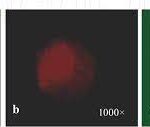Introduction
The development of new technologies, progressive urbanization, increasing consumerism, and industrial boom in developing countries has led to elevated pollution of the environment. The broad spectrum of pollutants produced and released to the environment has increased in the last few decades, including the agricultural, industrial, pharmaceutical, and plastic industries. These chemicals can be found in the individual elements of the environment, both living (biota) and non-living. Chemists very often pay attention only to chemical compounds, which are treated as substances foreign to the average chemical composition of individual elements of the environment or occur at levels higher than the so-called mean composition. However, attention should also be paid to legal aspects connected with the presence of specific pollutants in the individual elements of the environment, which are often defined as xenobiotics. Environmental research includes a broader spectrum of chemical individuals – xenobiotics – that need to be detected, identified, and determined. They can be divided into [1]:
· compounds that are already subjected to legal regulations because their physicochemical properties, as well as immediate and distant toxic effects (as a result of ecotoxicological tests), and appropriate methodologies are already available and it is possible to obtain reliable information about changes in the content of these analytes in various types of environmental samples. Thus, it was possible to propose appropriate standards defining the highest concentration of a given xenobiotic in a defined environmental element. These normative values are called the Maximum Admissible Concentration (MAC) in European countries and the Threshold Limit Value (TLV) in the United States [2, 3];
· compounds that are not subjected to legal regulations yet. This group includes xenobiotics detected in the environment because new analytical methodologies
were introduced into the analytical practice, which make it possible to detect and determine analytes occurring in tested environmental samples at very low levels (so-called micropollutants). It is said that the determined compounds have been so far called unidentified pollutants. The group of pollutants, which are not subjected to legal regulations, includes the so-called newly emerging pollutants [4]. These compounds are introduced into the individual elements of the environment as a result of new manifestations of human pressure, e.g. a new technology of manufacturing products or consumer goods. As a result, it has not been possible yet to define the ecotoxicological properties or develop and validate appropriate analytical procedures, which could make it possible to obtain reliable information about the levels of these compounds in various environmental samples. The occurrence of some specific micro-pollutants (EDCs), which are not subjected to legal regulation yet, has become more and more concerning in the last years [5]

THE BASICS OF HORMONAL REGULATION
To understand endocrine disruption, the basic features and mechanisms of the endocrine system must be explained. The endocrine system consists of a number of ductless glands that secrete hormones directly into the circulatory system (to the blood) in order to regulate various functions of the body. In turn, a hormone is called a special signaling molecule that is produced by an endocrine gland. Hormone molecules travel through the blood to target distant cells and tissues to regulate physiological functions and behavior [6].
The endocrine system is made up by the following glands:
· the pituitary gland at the base of the brain;
· the thyroid gland in the neck;
· the adrenal glands in the abdomen next to the kidneys;
· the gonads (ovaries and testes) and certain parts of the pancreas;
· the parathyroid gland;
· the thymus.
Next to these specialized endocrine glands, many other organs and tissues have secondary endocrine functions and secrete hormones (e.g. heart, adipose tissue, muscle, liver, kidneys) [7, 8]. Just to make a story short, every system of internal secretion glands, hormones, and final organs sensitive to given stressors can be named the hormonal system. With such systems, the organism can reach and hold the homeostasis. Hormones produce effects by acting on specialized proteins called receptors that attract and bind to specific hormones. Hormone receptors provide specificity to hormone actions, both in terms of the time and the place of hormone action. A receptor proteins superfamily consists of glucocorticoid, mineralocorticoid, androgen, estrogen, progesterone, retinoic acid, vitamin D, and thyroid receptors. Binding with ligand (antagonist or agonist) in vivo causes conformational changes, dimerization, and binding to a specific DNA sequence responding to characteristic receptor (see Figure 2) [1]. The target of the hormonal system is the activity of estrogenic, androgenic, thyroid, and glucocorticoids hormones. Classification of the hormones based on their structural properties is presented in Table 1. The modes of action of specific signaling systems are summarized in Figure 2 [1].
ENDOCRINE DISRUPTING COMPOUNDS AS XENOHORMONES
EDCs are chemicals responsible for the occurrence of disturbances in the hormonal balance of the organism. This group includes both egzogenic and endogenic substances or their mixtures that impact the function of the natural hormones in the organism [13]. Taking into account complexity and importance of hormones played in organisms functioning, it must be stated that endocrine chemicals have versatile and almost unlimited cells at low concentration levels. EDCs, also called xenohormones, disturb natural hormonal balance by modifying the functioning of the hormonal system in numerous ways [13-15]. Below are specified selected processes through which EDCs may influence human beings [8, 13, 16]:
· modifying hormones synthesis pathways;
· hormones excretion mechanisms;
· cell/tissue transport of hormones in the organism;
· binding to receptors;
· hormones degradation pathways.
· EDCs have also imprinted in the specific mechanisms of modifying organisms functioning, just to mention [15]:
· mimicking the endogenous hormones’ functioning;
· antagonism with synthesis of natural hormones or their metabolism;
· changes of level or activity of the hormonal receptors.
· EDCs can be assigned to one of two groups [17]:
· natural endocrine chemicals;
· chemicals emitted to the environment as a result of anthropopressio


A BRIEF HISTORY OF EDCS DISCOVERY
The first evidences of endocrine disruption in nature have been observed since the 1950s, but the source of the occuring phenomena was not known yet. Figure 3 shows the most important milestones in the development of the knowledge about endocrine disrupting micropollutants.
Currently, the studies on EDCs are spreading in all branches of science including analytical chemistry, toxicology, chemometrics (data treatment), modeling, chemical processing, etc. [30]. Their aim is to predict the environmental fate of these chemicals, EDCs’ potential to cause observable deformations, identify newly emerging pollutants, and assess the efficiency of novel sozotechnical methods being designed to reduce threats posed by EDCs. The next step – and the most difficult one – for sure will be validating and establishing legal frames to control the pollution level with EDC.


Since the 1960s, the huge increase of the number of such scientific papers has been observed. The rate of this increase is presented in Figure 4.

SCIENTIFIC CENTERS AND LABORATORIES DEALING WITH THE ISSUE OF EDC
There is still not enough knowledge about mechanisms, modes of action and the effects that endocrine disrupting compounds and their mixtures, which are present in the environment, have on single organisms and on whole ecosystems. That is the reason why researches in this field of expertise are being held in numerous scientific centers and laboratories all over the world. In Table 2, the above mentioned scientific units are presented. The studies conducted are aimed at:
· developing new analytical methodologies and their validation;
· the use of various procedures to obtain information about the content of various groups of xenobiotics in samples collected from various elements of non-living environment and biota samples.

Health effects
HARMFUL HEALTH EFFECTS OF EDCS ON VERTEBRATES
HUMANS
Until now, there is no clear opinion in the scientific circles concerning the harmful effects of EDCs. However, it is hard to remain calm as the review of literature concerning the issues connected to environmental chemistry and ecotoxicology shows an increasing number of articles showing a relation between the presence of xenobiotics in the environment and the annually increasing rate of incidence of various kinds of neoplasms, distorted reproductive behavior, and an increasing level of feminization of specific populations at different levels of the food chain. Even though the majority of those studies has been conducted on animals, there is evidence confirming the negative effect of even small doses of those substances have on humans [31]. The EDC group compounds are characterized by a similar structural construction to natural estrogens. Although the activity of many xenoestrogens has been estimated to be lower than the activity of the feminine sex hormone estradiol, numerous in vitro studies indicate its capability of binding with ERα, Estrogen Receptors, and aryl hydrocarbon and thyroid hormones receptors. These properties are the reason why estrogen is suspected to cause diseases resulting from hormonal disorders, including: fertility problems, heart diseases, circulatory problems, and diabetes [32]. The data published during the last few years more and more often indicates to a relation between identification and the growing levels of EDCs in various biological samples and the global problem of obesity, which occurs on an epidemic scale. In addition, as the latest reports from the scientific world indicate, many of these compounds may have an influence on organisms not only through receptors.
The epigenetic tests conducted have confirmed that these compounds influence the process of methylation of histone proteins, influencing alterations in the molecule expression. There are many concerns regarding the fact that these contaminations are capable of crossing the placenta barrier and the blood-brain barrier, and thus, they may have a negative influence on organisms since the early stages of their lives. This fact has been confirmed in many epidemiological studies and experiments, what indicates to a strong correlation between an exposure of the mother to the activity of xenobiotics and the occurrence of neurodevelopmental disorders of her offspring, such as ADHD, autism, or alterations in behavioural development as well as impairment of cognitive functions [33]. There are many indications that show that the compound may be also responsible for the initiation of carcinogenesis, that is why studies conducted in numerous research centers are aimed at finding the relations between the presence of xenoestrogens in the human body and the frequency of incidence of neoplasms of e.g., the testicles, prostate, uterus, ovaries, and breasts [34].
Humans may be exposed to the harmful effects of the EDCs via many ways as presented in Figure 5. [7].

WILDLIFE
Most data about the adverse effects of endocrine disruptors present in the environment on wild aimals come from Europe and North America. Observed changes vary from very subtle, such as small changes in the physiology and sexual behavior of some species to permanently altered sexual diferentiation. Most affected are aquatic species located on the top of the food chain, but some effects have also been observed in terrestial species. Table 3 provides information concerning some health effects induced by EDCs on wildlife [5].



HARMFUL HEALTH EFFECTS OF EDCS ON INVERTEBRATES
There is still not enough knowledge on endocrine effects on invertebrates; however, these organisms seem to be good intermediates in modeling hormonal potential toward higher organisms. There are some historical reports in which females have exhibited signs of masculinization, apparently in association with exposure to EDCs. Exposure of marine gastropods to Tributyltin (TBT), a biocide used in anti-fouling paints, provides the clearest example in invertebrates of an endocrine-mediated adverse effect caused by exposure to an environmental contaminant. Masculinization of marine gastropods exposed to TBT has resulted in worldwide declines of gastropods. The endocrine mechanism probably involves elevated androgen levels possibly through altered aromatase activity. Tributyltin-induced imposex in prosobranch female snails is a condition in which the penis “imposes” on the normal female reproductive anatomy. The associated development of the sperm duct can, in extreme cases, lead to the blockage of the oviduct of the female, resulting in sterility and population declines [1, 5, 7].
Environmental fate
Fate and transport data interpretation is a very challenging task to perform. Although the amount of information is sufficient, it is crucial to identify critical processes and transport pathways for prioritization and screening purposes. Analyzing the ways the endocrine active compunds enter the enviornment, it can be distinguished as an nonpoint or a one point source of pollution. Areas affected with pollution are mainly stream downs from cornfields and farm areas where different types of plant protetction products and fertilizers are used, which can contain significant quantities of pharmaceutical residue. Smaller quantities can reach the ecosystems by precipitation. There’s no doubt that the main source of xenoestrogene emissions to the enviornment are one point pollutuion sources. A significant part of the EDC group compounds is reaching water ecosystems with sewage. And with that occuring, surface waters and underground waters have higher levels of concentration of these substances than in air or soil. Residue of pharamceuticals and other substances that are biologically active coming from sources such as houses, hospitals, and production plants head to the sewer plants where they undergo different processes of water purification. Unfortunately, due to their physicochemical properties, they are resistant to biodegradation processes. This results in significant quantities of residue are not eliminated and get across to water ecosystems or with sewage sludge to the soil, groundwaters, and drinking waters. The ineptitude of widely used water purification systems has caused all the elements of the environment to be polluted by endocrine compounds. Xenobiotics, after reaching water ecosystems, undergo many different changes in chemical processes in living organisms as well as the abiotic part of the environment.
There are three environmental processes that affect the environmental fate of EDCs (as well as other pollutants). They are defined as:
· Persistence – the tendency of a chemical substance or its degradation products to survive in the environment without being transformed into other forms, (measure: hydrolysis half-life, aerobic and anaerobic soil metabolism, and photolysis).
· Mobility – the tendency of a chemical substance to move within environmental media or between media (measure: volatility, Henry’s law constant, Kd, Koc, groundwater ubiquitous score, aged soil column leaching, and terrestrial field dissipation studies).
· Bioaccumulation – the capacity of a chemical to accumulate (be stored in tissue) in an organism as a result of uptake from all environmental sources (measure: octanol water partition coefficient, BCF, and animal metabolism).
The environmental fate of endocrine disruptors is shown schematically in Figure 6 [35]. Compounds interfereing in the endocrine balance can undergo biodegradation, photodegradation, sedimantation, elimination hydrolisys, or sorption on the matter particules suspended in water. The level on which they will be adsorbed depends on the physical and chemical properties and affinity to the particles present in water [35, 36]. Compounds included in this group, just like other types of xenobiotics, may undergo the bioaccumulation process in tissues and organs of organisms at higher trophic levels. This thesis is confirmed by data on toxaphene presented in Table 4. Toxaphene is an insecticide contained in over 670 products. Toxaphene is characterised by toxicity, stability, and ability to bioaccumulate in animals and to travel long distances. Toxaphene is poorly soluble in water, so it can be found in the air, soil, or sediments on the bottom of lakes and streams [37]. In the 1970s, toxaphene was one of the most commonly used pesticides in the world [38, 39].


Toxaphene was used for fighting pest insects feeding on cotton, grain, fruits, nuts, and vegetables. In the 1970s, fishing and hunting agencies also used toxaphene for killing fish species that were considered undesirable. It was also used for fighting ticks and other acari in domestic animals and poultry. Toxaphene is currently banned in the USA and in 57 other countries worldwide, while in other 12 countries, its use is strictly restricted. At the beginning of the 1990s, toxaphene was produced in Africa and Latin America; it is estimated that it is used in the largest quantities in Africa [37, 40].

Analysis and monitoring of EDCs in environmental samples
From a historical point of view, the instrumental techniques were first tools to determine trace organic pollutant concentration levels in the environment. With the run of time albo biological methods were introduced into the scientific routine to obtain more comprehensive and reliable information of the pollution levels of given environemtnal compartments. In Figure 7, (A and B below), basic instrumental and biological data together with their short description to present the development of tools in the field of endocrine potency determination with biological methods are presented


BIOLOGICAL CELLULAR TESTS USED TO ASSESS THE ENDOCRINE POTENCY OF THE ENVIRONMENTAL SAMPLES
Cellular biotests are good alternative to traditional analytical procedures, as well as to immunotechniques and methods utilizing living organisms as biomarkers of exposure to EDC [91]. In these types of biotests, the yeast or human cells (e.g. cells of breast or kidney cancer) are used to determine disturbances in the run of hormonal signaling [92]. The cells can be used in unchanged form or altered with proper bioengineering methods to obtain the proper response of cells to the presence of specific chemicals belonging to EDC [93]. For example, the estrogen gene can be introduced to the yeast cells from human, fish, or other species genome. In such case, the term of estrogen equivalent concentration (EEC) finds its application in the form of the formula [42]:

where:
CiCi – concentration of particular EDC in the sample studiedEEFiEEFi – numerical value of the endocrine equivalent factor
Numerical values of this factor determines in the relative way the endocrine character of given the chemical in relation to the endocrine potency of the reference chemical, most often estradiol or 17β-estradiol.
In this way, the endocrine potency can be described using the equation [32]:

In Table 5, there are given numerical values of EFF of selected chemicals belonging to EDC

In Table 6, the data concerning the analysis of various samples with bioassays is given.




ANALYTICAL AND INSTRUMENTAL METHODS USED FOR DETECTING EDCS
Detection, identification, and quantitative determination of EDC-like chemicals are currently achieved mostly with chromatographic techniques. Prior to chromatographic separation and detection (mostly with mass spectrometry or time of flight detection), complex and time- and labor-consuming sample treatment are necessary as presented in Figure 8 (as exmple on the basis of data revision [67,68]).

· Pre-treatment
Water and sewage samples collected for determination of endocrine disrupting compounds contain other various impurities. At this moment of sample treatment, the majority of samples is subjected to filtration to remove solid impurities. Pre-existing coagulation facilitates the filtration. Then the sulfuric acid, hydrochloric acid, methanol, or formaldehyde can be added to the samples to obtain the appropriate pH. The addition of one of these compounds also prevents the degradation of the assayed analytes. Samples are stored in darkness and low temperature, usually <4oC, in bottles made of amber glass to avoid photodegradation of analytes [69, 70].
The usual method of trace organic pollutants extraction is solid-phase extraction (SPE). The first step is filling the column-conditioning of the sorbent. After conditioning, the column is percolated with test sample. The target analytes and other compounds absorb in the sorbent. The next step is the elution of interfering compounds from the column. At the end, the target compounds are eluted with proper solvent mixtures. Solid phase extraction can be either: on-line where the extraction is directly integrated into the system of the quantitative analysis; or it may be off-line where the extraction column is not connected in any way with the gas or liquid chromatograph. In on-line SPE, full automation of the process occurs and the method is characterized with ease of application of samples and a large throughput. However, despite the higher costs off-line SPE, it is often used because when combined with GC, water must be removed totally prior to eluting analytes [70]. When choosing the appropriate sorbent for the SPE column, one has to take into account the chemical and physical properties of assayed compounds. One of the most frequently used cartridge packing is Oasis HLB. It allows to obtain high recovery of both the acidic, basic, and neutral compounds. Recovery exceeds 70%. This sorbent can be used for the large range of pH of the samples, ranging from 2–7. Lichrolut ENV+ cartridges are used when the sample has a low pH and contains polar organic compounds or when sample contains neutral drugs and its pH is neutral. Columns packed with C-18 are suitable for non-polar or moderately polar compounds. The extraction process must then be optimized: sample volume, the volume of sorbent cartridge, percolation rate, type of eluent and its volume. The elution solvent is selected depending on the properties of the compounds eluted and its elution strength.
A less frequently used method is the Solid Phase Microextraction (SPME). It depends on the distribution of the analyzed chemical compounds between the sample and the sorbent. This method is fast, moderately new, and an easy method of extraction. SPME coupled with GC content allows the study of semivolatile, volatile, and non-polar analytes. More difficult is the combination of this technique with liquid chromatography. Non-volatile compounds are not totally desorbed during the thermal desorption. SPME has many advantages thus it is more attractive than the SPE method, but has a more restricted choice of sorbent and too little sorption capacity. Therefore, the parameters of this technique are still optimized for wider application and greater sensitivity. Samples after SPE or SPME are concentrated using evaporation under a gentle nitrogen stream [70]. Another common method of extraction is liquid-liquid extraction (LLE). LLE relies on shaking the sample with an organic solvent for a specified period of time. One can perform this operation several times. The organic phase is separated from the water, and mixture of all the extracts is obtained. The resulting solution is dried, for example, using anhydrous sodium sulfite. When the sample volume is sufficiently small, determination of analytes can be started [71].
· Determination of concentration levels of target analytes
Liquid chromatography combined with tandem mass spectrometer is the most widely used analytical technique because it allows ion fragmentation that is needed for accurate and precise determination of the analytes. LC-MS/MS determines the compounds that have identical molecular weight but disparate product ions. Using MS/MS increases the selectivity and sensitivity of the method. Atmospheric pressure chemical and electrospray ionization (APCI and ESI) are modes of ionization interfaces that are the most widely used with LC-MS/MS. Low or medium polar compounds are determined by APCI, and the analysis of polar analytes is conducted using ESI. The main use of liquid chromatography is to determine non-volatile, polar, or degradable under high temperature substances. For example, beta-blockers and antibiotics can by analyzed using only LC-MS/MS [70].
One of the biggest difficulties with LC-MS/MS is interference in the matrix effects. This effect causes the strengthening or suppression of the analyte signal, thus producing erroneous results. When contaminated environmental samples are analyzed, for example wastewater, it is necessary to perform efficient clean up of samples. The process of optimizing the analytical methods, such as of liquid chromatography, involves making a series of studies to determine the parameters that give the best results for all determined substances. MS parameters are also optimized for each analyte by conducting the flow injection analysis (FIA). To obtain credible results, it is needed to optimize the separation of compounds by liquid chromatography and mass spectrometry parameters. In case of GC-MS analysis, the matrix effects occur less frequently than during the analysis of LC-MS/MS. The disadvantage is that it is a more time-consuming technique and requires complex preparation of the sample in case of derivatization step.
As a result of derivatization of polar components, their analogs are less polar and more thermostable. It increases the sensitivity of analysis but also increases the loss of sample by performing additional operations. A negative aspect of derivatization is the use of carcinogenic and toxic reagents. Derivatization reaction should allow the detection of analytes that have polar functional groups. It is effective when the reaction occurs in a given time with 90% efficiency. In literature there can be found many applications of GC-MS for the analysis of drugs, PAHs, PCBs, and other pollutants in water and wastewater samples [70]. In Table 7, there are presented examples of determining the EDCs in environmental samples, mainly in samples of river, drinking, surface, and sewage water. They are also determined in samples of food, air, in the tissues of the Chinese sturgeon, in house dust, and in human serum. It can be stated that LC-MS/MS and GC-MS are the most often used techniques in determining EDCs. Other methods such as high performance liquid chromatography with fluorescence or diode array detector are less frequently used in the analysis of EDCs. The best results are given by the combination of LC-MS/MS with GC-MS.
On the basis of data collected in Table 1, it can be concluded that people and other living organisms are exposed to EDCs throughout their entire life. Even low concentrations levels of EDCs can have a significant impact on animal and human health and the existence/health state of entire populations. Many people do not realize that even these small amounts can be significantly harmful after long exposure. The concentration of some compounds from the EDC groups has decreased because their application was banned. Unfortunately, they have long half-lives, so trace amounts are present in the samples assayed decades after the release of specific chemicals. Determination of EDCs poses many challenges and problems. Newer and more accurate analytical methods are required and need to be used by the scientific community. There are more and more articles/books about detection of EDCs in environmental samples and their harmfulness. Application of EDC should be reduced as far as possible because contamination of these compounds poses a huge risk to the environment.


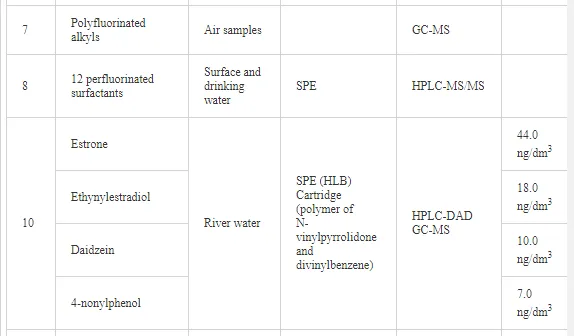

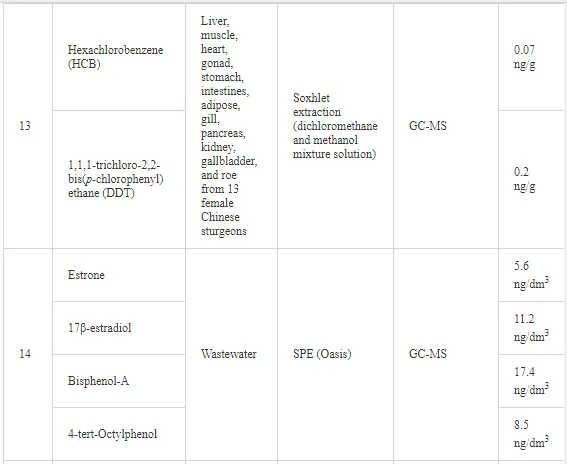
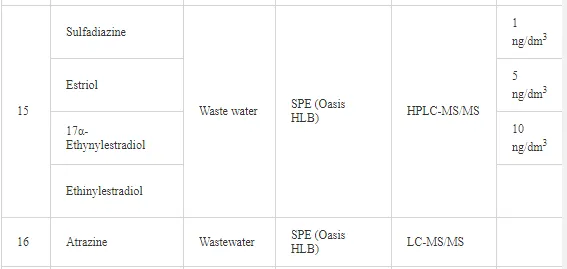
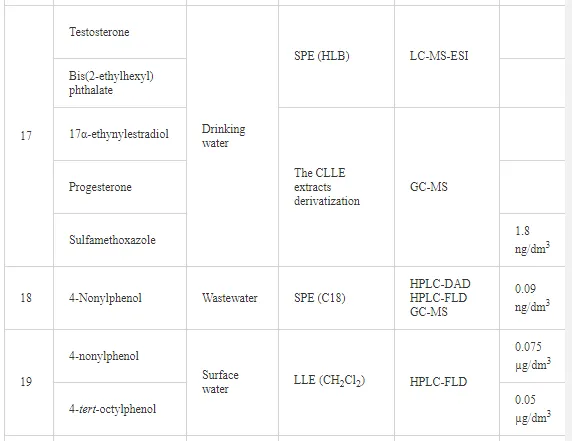


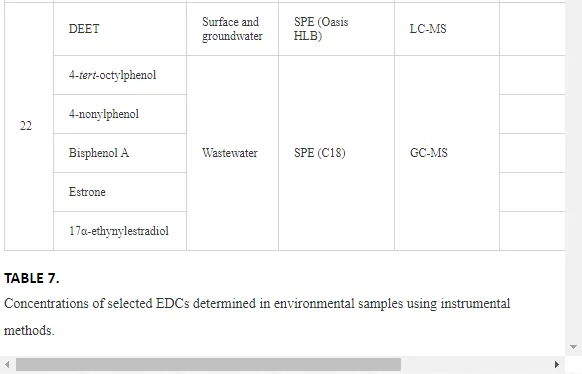
Summary
The poor state of knowledge about the mechanisms of action and effects of EDC chemicals has forced the interdisciplinary scientific teams to intensify their work in the subject. Nowadays, many institutes are carrying out research focused on exploring the properties and metabolic pathways of EDCs and their mixtures in the environment. Good knowledge about the environmental fate, endocrine potential, and distant toxic effects of ecoestrogens will allow to estimate the levels of the pollution and minimal exposure on certain compounds. Moreover, this knowledge can be applied for upgrading the common tools used to detect and perform quantitative determination of EDCs, and can be the basis for the development of new techniques that will provide information about the composition of the sample and about its endocrine potential [94,95]. The discovery of micropollutants occurring in the environment resulted in new methodologies being put into the analytical practice. These methodologies are developed in two different directions. The first is based on methodological solutions designed to detect, identify, and determine xenobiotics that occur in various environmental samples. For this purpose, instrumental methods such as gas and liquid chromatography with mass spectrometry detection are usually used. These techniques provide reliable information about the presence, quantity, and influence of EDCs. The second approach is to put into the analytical practice new bioanalytical methodologies. These methodologies allow estimation of the sample endocrine potential, but they do not provide information on which of the sample ingredient is responsible for causing the toxic effect. The results of the analysis of this biological response are valuable source of information for chemists and ecotoxicologists. These results can be the basis for estimating the endocrine potential of the environment exhibited by certain species. Moreover, bioanalytical techniques may be supplementary to the techniques of quantitative and qualitative determination of endocrine disrupting chemicals. It is not possible to estimate the environmental risk of EDC presence based only on the information about the sample composition. It is necessary to determine both the magnitude and how in particular the endocrine homeostasis may be impacted by xenobiotics. These tasks can be realized only by using a well-chosen bioassays battery. In the recent years there has been a significant increase in the importance of the biological methodologies in environmental research because of their numerous advantages. It is reflected in the research literature and in the increase in the number of scientific publications on this subject. In this chapter the information about some of the estrogenic compounds, their environmental fate, and biological influence can be found. Special attention was given paid to the review of the analytical approaches used at the stage of detection and determination of EDCs in the environmental samples. Also a brief characterization of both the cellular and non-cellular bioassays is presented, as well as the information regarding the changes occurring in the bioindicators as results of being exposed to a specific ecotoxins.

